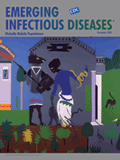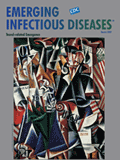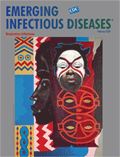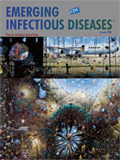Medscape CME Activity
Medscape, LLC is pleased to provide online continuing medical education (CME) for selected journal articles, allowing clinicians the opportunity to earn CME credit. In support of improving patient care, these activities have been planned and implemented by Medscape, LLC and Emerging Infectious Diseases. Medscape, LLC is jointly accredited by the Accreditation Council for Continuing Medical Education (ACCME), the Accreditation Council for Pharmacy Education (ACPE), and the American Nurses Credentialing Center (ANCC), to provide continuing education for the healthcare team.
CME credit is available for one year after publication.
Volume 15—2009
Volume 15, Number 12—December 2009

Community-associated methicillin-resistant Staphylococcus aureus (CA-MRSA) has become a major problem in US hospitals already dealing with high levels of hospital-associated MRSA (HA-MRSA). Using antimicrobial drug susceptibility data for 1999–2006 from The Surveillance Network, we characterized the relationship between outpatient and inpatient levels of CA-MRSA nationally. In outpatients, the frequency of CA-MRSA isolates has increased >7× during 1999–2006, which suggests that outpatients have become a major reservoir for CA-MRSA. However, contrary to results in other reports, although CA-MRSA increases are associated with decreases in the frequency of HA-MRSA in hospitals, the decreases are only modest. This finding suggests that instead of replacing HA-MRSA in the hospital, CA-MRSA is adding to the overall presence of MRSA already found within the hospital population.
| EID | Klein E, Smith DL, Laxminarayan R. Community-associated Methicillin-Resistant Staphylococcus aureus in Outpatients, United States, 1999–2006. Emerg Infect Dis. 2009;15(12):1925-1930. https://doi.org/10.3201/eid1512.081341 |
|---|---|
| AMA | Klein E, Smith DL, Laxminarayan R. Community-associated Methicillin-Resistant Staphylococcus aureus in Outpatients, United States, 1999–2006. Emerging Infectious Diseases. 2009;15(12):1925-1930. doi:10.3201/eid1512.081341. |
| APA | Klein, E., Smith, D. L., & Laxminarayan, R. (2009). Community-associated Methicillin-Resistant Staphylococcus aureus in Outpatients, United States, 1999–2006. Emerging Infectious Diseases, 15(12), 1925-1930. https://doi.org/10.3201/eid1512.081341. |
Volume 15, Number 11—November 2009

| EID | Jensenius M, Davis X, von Sonnenburg F, Schwartz E, Keystone JS, Leder K, et al. Multicenter GeoSentinel Analysis of Rickettsial Diseases in International Travelers, 1996–2008. Emerg Infect Dis. 2009;15(11):1791-1798. https://doi.org/10.3201/eid1511.090677 |
|---|---|
| AMA | Jensenius M, Davis X, von Sonnenburg F, et al. Multicenter GeoSentinel Analysis of Rickettsial Diseases in International Travelers, 1996–2008. Emerging Infectious Diseases. 2009;15(11):1791-1798. doi:10.3201/eid1511.090677. |
| APA | Jensenius, M., Davis, X., von Sonnenburg, F., Schwartz, E., Keystone, J. S., Leder, K....Parola, P. (2009). Multicenter GeoSentinel Analysis of Rickettsial Diseases in International Travelers, 1996–2008. Emerging Infectious Diseases, 15(11), 1791-1798. https://doi.org/10.3201/eid1511.090677. |
Volume 15, Number 10—October 2009

We performed antimicrobial drug susceptibility testing and molecular typing on invasive methicillin-resistant Staphylococcus aureus (MRSA) isolates (n = 1,666) submitted to the University of Iowa Hygienic Laboratory during 1999–2006 as part of a statewide surveillance system. All USA300 and USA400 isolates were resistant to <3 non–β-lactam antimicrobial drug classes. The proportion of MRSA isolates from invasive infections that were either USA300 or USA400 increased significantly from 1999–2005 through 2006 (p<0.0001). During 2006, the incidence of invasive community-associated (CA)–MRSA infections was highest in the summer (p = 0.0004). Age <69 years was associated with an increased risk for invasive CA-MRSA infection (odds ratio [OR] 5.1, 95% confidence interval [CI] 2.06–12.64), and hospital exposure was associated with decreased risk (OR 0.07, 95% CI 0.01–0.51).
| EID | Van De Griend P, Herwaldt LA, Alvis B, DeMartino M, Heilmann K, Doern G, et al. Community-Associated Methicillin-Resistant Staphylococcus aureus, Iowa, USA. Emerg Infect Dis. 2009;15(10):1582-1589. https://doi.org/10.3201/eid1510.080877 |
|---|---|
| AMA | Van De Griend P, Herwaldt LA, Alvis B, et al. Community-Associated Methicillin-Resistant Staphylococcus aureus, Iowa, USA. Emerging Infectious Diseases. 2009;15(10):1582-1589. doi:10.3201/eid1510.080877. |
| APA | Van De Griend, P., Herwaldt, L. A., Alvis, B., DeMartino, M., Heilmann, K., Doern, G....Diekema, D. (2009). Community-Associated Methicillin-Resistant Staphylococcus aureus, Iowa, USA. Emerging Infectious Diseases, 15(10), 1582-1589. https://doi.org/10.3201/eid1510.080877. |
Volume 15, Number 8—August 2009

An outbreak of Acanthamoeba keratitis, a rare, potentially blinding, corneal infection, was detected in the United States in 2007; cases had been increasing since 2004. A case–control study was conducted to investigate the outbreak. We interviewed 105 case-patients from 30 states and 184 controls matched geographically and by contact lens use. Available contact lenses, cases, solutions, and corneal specimens from case-patients were cultured and tested by molecular methods. In multivariate analyses, case-patients had significantly greater odds of having used Advanced Medical Optics Complete Moisture Plus (AMOCMP) solution (odds ratio 16.9, 95% confidence interval 4.8–59.5). AMOCMP manufacturing lot information was available for 22 case-patients, but none of the lots were identical. Three unopened bottles of AMOCMP tested negative for Acanthamoeba spp. Our findings suggest that the solution was not intrinsically contaminated and that its anti-Acanthamoeba efficacy was insufficient. Premarket standardized testing of contact lens solutions for activity against Acanthamoeba spp. is warranted.
| EID | Verani JR, Lorick SA, Yoder JS, Beach MJ, Braden CR, Roberts JM, et al. National Outbreak of Acanthamoeba Keratitis Associated with Use of a Contact Lens Solution, United States. Emerg Infect Dis. 2009;15(8):1236-1242. https://doi.org/10.3201/eid1508.090225 |
|---|---|
| AMA | Verani JR, Lorick SA, Yoder JS, et al. National Outbreak of Acanthamoeba Keratitis Associated with Use of a Contact Lens Solution, United States. Emerging Infectious Diseases. 2009;15(8):1236-1242. doi:10.3201/eid1508.090225. |
| APA | Verani, J. R., Lorick, S. A., Yoder, J. S., Beach, M. J., Braden, C. R., Roberts, J. M....Roy, S. L. (2009). National Outbreak of Acanthamoeba Keratitis Associated with Use of a Contact Lens Solution, United States. Emerging Infectious Diseases, 15(8), 1236-1242. https://doi.org/10.3201/eid1508.090225. |
Volume 15, Number 7—July 2009

In February 2006, a diagnosis of sylvatic epidemic typhus in a counselor at a wilderness camp in Pennsylvania prompted a retrospective investigation. From January 2004 through January 2006, 3 more cases were identified. All had been counselors at the camp and had experienced febrile illness with myalgia, chills, and sweats; 2 had been hospitalized. All patients had slept in the same cabin and reported having seen and heard flying squirrels inside the wall adjacent to their bed. Serum from each patient had evidence of infection with Rickettsia prowazekii. Analysis of blood and tissue from 14 southern flying squirrels trapped in the woodlands around the cabin indicated that 71% were infected with R. prowazekii. Education and control measures to exclude flying squirrels from housing are essential to reduce the likelihood of sylvatic epidemic typhus.
| EID | Chapman AS, Swerdlow DL, Dato VM, Anderson AD, Moodie CE, Marriott C, et al. Cluster of Sylvatic Epidemic Typhus Cases Associated with Flying Squirrels, 2004–2006. Emerg Infect Dis. 2009;15(7):1005-1011. https://doi.org/10.3201/eid1507.081305 |
|---|---|
| AMA | Chapman AS, Swerdlow DL, Dato VM, et al. Cluster of Sylvatic Epidemic Typhus Cases Associated with Flying Squirrels, 2004–2006. Emerging Infectious Diseases. 2009;15(7):1005-1011. doi:10.3201/eid1507.081305. |
| APA | Chapman, A. S., Swerdlow, D. L., Dato, V. M., Anderson, A. D., Moodie, C. E., Marriott, C....Dasch, G. A. (2009). Cluster of Sylvatic Epidemic Typhus Cases Associated with Flying Squirrels, 2004–2006. Emerging Infectious Diseases, 15(7), 1005-1011. https://doi.org/10.3201/eid1507.081305. |
Volume 15, Number 6—June 2009

Influenza A subtype H7 viruses have resulted in >100 cases of human infection since 2002 in the Netherlands, Italy, Canada, the United States, and the United Kingdom. Clinical illness from subtype H7 infection ranges from conjunctivitis to mild upper respiratory illness to pneumonia. Although subtype H7 infections have resulted in a smaller proportion of hospitalizations and deaths in humans than those caused by subtype H5N1, some subtype H7 strains appear more adapted for human infection on the basis of their virus-binding properties and illness rates among exposed persons. Moreover, increased isolation of subtype H7 influenza viruses from poultry and the ability of this subtype to cause severe human disease underscore the need for continued surveillance and characterization of these viruses. We review the history of human infection caused by subtype H7. In addition, we discuss recently identified molecular correlates of subtype H7 virus pathogenesis and assess current measures to prevent future subtype H7 virus infection.
| EID | Belser JA, Bridges CB, Katz JM, Tumpey TM. Past, Present, and Possible Future Human Infection with Influenza Virus A Subtype H7. Emerg Infect Dis. 2009;15(6):859-865. https://doi.org/10.3201/eid1506.090072 |
|---|---|
| AMA | Belser JA, Bridges CB, Katz JM, et al. Past, Present, and Possible Future Human Infection with Influenza Virus A Subtype H7. Emerging Infectious Diseases. 2009;15(6):859-865. doi:10.3201/eid1506.090072. |
| APA | Belser, J. A., Bridges, C. B., Katz, J. M., & Tumpey, T. M. (2009). Past, Present, and Possible Future Human Infection with Influenza Virus A Subtype H7. Emerging Infectious Diseases, 15(6), 859-865. https://doi.org/10.3201/eid1506.090072. |
Volume 15, Number 5—May 2009

To determine whether HIV-1 infection and HIV-1–related immunosuppression were risk factors for severe malaria in adults with some immunity to malaria, we conducted a case–control study in Luanshya, Zambia, during December 2005–March 2007. For each case-patient with severe malaria, we selected 2 matched controls (an adult with uncomplicated malaria and an adult without signs of disease). HIV-1 infection was present in 93% of case-patients, in 52% of controls with uncomplicated malaria, and in 45% of asymptomatic controls. HIV-1 infection was a highly significant risk factor for adults with severe malaria compared with controls with uncomplicated malaria (odds ratio [OR] 12.6, 95% confidence interval [CI] 2.0–78.8, p = 0.0005) and asymptomatic controls (OR 16.6, 95% CI 2.5–111.5, p = 0.0005). Persons with severe malaria were more likely to have a CD4 count <350/µL than were asymptomatic controls (OR 23.0, 95% CI 3.35–158.00, p<0.0001).
| EID | Chalwe V, Mukwamataba D, Menten J, Kamalamba J, Mulenga M, D’Alessandro U, et al. Increased Risk for Severe Malaria in HIV-1–infected Adults, Zambia. Emerg Infect Dis. 2009;15(5):749-755. https://doi.org/10.3201/eid1505.081009 |
|---|---|
| AMA | Chalwe V, Mukwamataba D, Menten J, et al. Increased Risk for Severe Malaria in HIV-1–infected Adults, Zambia. Emerging Infectious Diseases. 2009;15(5):749-755. doi:10.3201/eid1505.081009. |
| APA | Chalwe, V., Mukwamataba, D., Menten, J., Kamalamba, J., Mulenga, M., D’Alessandro, U....Van Geertruyden, J. (2009). Increased Risk for Severe Malaria in HIV-1–infected Adults, Zambia. Emerging Infectious Diseases, 15(5), 749-755. https://doi.org/10.3201/eid1505.081009. |
Volume 15, Number 4—April 2009

We conducted an epidemiologic investigation of an outbreak of ocular disease among children to determine whether the disease was linked to Emmonsia sp., a rarely-reported fungus and an agent of adiaspiromycosis. Using an unmatched case–control study design, we compared case-patients with asymptomatic controls randomly selected from the population. Scleral biopsies were analyzed microscopically. Of 5,084 children examined, 99 case-patients were identified; mean age (+1 SD) was 11.0 ± 4.4 years. Symptoms included photophobia (57%), ocular pain (42%), and blurred vision (40%). In the multivariate analysis, risk factors included diving in the Araguaia River (odds ratio 5.2; 95% confidence interval 2.4–12.0). Microscopy identified foreign bodies consistent with adiaconidia. This outbreak probably resulted from foreign-body–type reactions to adiaspiromycosis conidia after initial irritation caused by conjunctival contact with spicules of sponges in the river. Symptomatic children responded to corticosteroid treatment. Adiaspiromycosis is a preventable cause of ocular disease in the Amazon region.
| EID | Mendes MO, Moraes MA, Renoiner EI, Dantas MH, Lanzieri TM, Fonseca CF, et al. Acute Conjunctivitis with Episcleritis and Anterior Uveitis Linked to Adiaspiromycosis and Freshwater Sponges, Amazon Region, Brazil, 2005. Emerg Infect Dis. 2009;15(4):633-639. https://doi.org/10.3201/eid1504.081281 |
|---|---|
| AMA | Mendes MO, Moraes MA, Renoiner EI, et al. Acute Conjunctivitis with Episcleritis and Anterior Uveitis Linked to Adiaspiromycosis and Freshwater Sponges, Amazon Region, Brazil, 2005. Emerging Infectious Diseases. 2009;15(4):633-639. doi:10.3201/eid1504.081281. |
| APA | Mendes, M. O., Moraes, M. A., Renoiner, E. I., Dantas, M. H., Lanzieri, T. M., Fonseca, C. F....Hatch, D. L. (2009). Acute Conjunctivitis with Episcleritis and Anterior Uveitis Linked to Adiaspiromycosis and Freshwater Sponges, Amazon Region, Brazil, 2005. Emerging Infectious Diseases, 15(4), 633-639. https://doi.org/10.3201/eid1504.081281. |
Volume 15, Number 3—March 2009

Identifying patients who are at high risk for severe Clostridium difficile–associated disease (CDAD) early in the course of their infection may help clinicians improve outcomes. Therefore, we compared clinical features associated with severe versus nonsevere CDAD by retrospectively reviewing records of hospitalized patients whose fecal assays were positive for C. difficile toxin. Of 336 patients, 12.2% had severe disease and 10.1% died from all causes. Regression modeling showed the following to be significantly associated with severe CDAD (p<0.05): age >70 years (odds ratio [OR] 3.35), maximum leukocyte count >20,000 cells/mL (OR 2.77), minimum albumin level <2.5 g/dL (OR 3.44), maximum creatinine level >2 mg/dL (OR 2.47), small bowel obstruction or ileus (OR 3.06), and computed tomography scan showing colorectal inflammation (OR 13.54). These clinical and laboratory markers for severe disease may be useful for identifying patients at risk for serious outcomes or death.
| EID | Henrich TJ, Krakower D, Bitton A, Yokoe DS. Clinical Risk Factors for Severe Clostridium difficile–associated Disease. Emerg Infect Dis. 2009;15(3):415-422. https://doi.org/10.3201/eid1503.080312 |
|---|---|
| AMA | Henrich TJ, Krakower D, Bitton A, et al. Clinical Risk Factors for Severe Clostridium difficile–associated Disease. Emerging Infectious Diseases. 2009;15(3):415-422. doi:10.3201/eid1503.080312. |
| APA | Henrich, T. J., Krakower, D., Bitton, A., & Yokoe, D. S. (2009). Clinical Risk Factors for Severe Clostridium difficile–associated Disease. Emerging Infectious Diseases, 15(3), 415-422. https://doi.org/10.3201/eid1503.080312. |
Volume 15, Number 2—February 2009

Many countries are stockpiling face masks for use as a nonpharmaceutical intervention to control virus transmission during an influenza pandemic. We conducted a prospective cluster-randomized trial comparing surgical masks, non–fit-tested P2 masks, and no masks in prevention of influenza-like illness (ILI) in households. Mask use adherence was self-reported. During the 2006 and 2007 winter seasons, 286 exposed adults from 143 households who had been exposed to a child with clinical respiratory illness were recruited. We found that adherence to mask use significantly reduced the risk for ILI-associated infection, but <50% of participants wore masks most of the time. We concluded that household use of face masks is associated with low adherence and is ineffective for controlling seasonal respiratory disease. However, during a severe pandemic when use of face masks might be greater, pandemic transmission in households could be reduced. Many countries are stockpiling face masks for use as nonpharmaceutical interventions to reduce viral transmission during an influenza pandemic. We conducted a prospective cluster-randomized trial comparing surgical masks, non–fit-tested P2 masks, and no masks in prevention of influenza-like illness (ILI) in households. During the 2006 and 2007 winter seasons, 286 exposed adults from 143 households who had been exposed to a child with clinical respiratory illness were recruited. Intent-to-treat analysis showed no significant difference in the relative risk of ILI in the mask use groups compared with the control group; however, <50% of those in the mask use groups reported wearing masks most of the time. Adherence to mask use was associated with a significantly reduced risk of ILI-associated infection. We concluded that household use of masks is associated with low adherence and is ineffective in controlling seasonal ILI. If adherence were greater, mask use might reduce transmission during a severe influenza pandemic.
| EID | MacIntyre C, Cauchemez S, Dwyer DE, Seale H, Cheung P, Browne G, et al. Face Mask Use and Control of Respiratory Virus Transmission in Households. Emerg Infect Dis. 2009;15(2):233-241. https://doi.org/10.3201/eid1502.081167 |
|---|---|
| AMA | MacIntyre C, Cauchemez S, Dwyer DE, et al. Face Mask Use and Control of Respiratory Virus Transmission in Households. Emerging Infectious Diseases. 2009;15(2):233-241. doi:10.3201/eid1502.081167. |
| APA | MacIntyre, C., Cauchemez, S., Dwyer, D. E., Seale, H., Cheung, P., Browne, G....Ferguson, N. (2009). Face Mask Use and Control of Respiratory Virus Transmission in Households. Emerging Infectious Diseases, 15(2), 233-241. https://doi.org/10.3201/eid1502.081167. |
Volume 15, Number 1—January 2009

Nationally distributed medications from compounding pharmacies, which typically adhere to less stringent quality-control standards than pharmaceutical manufacturers, can lead to multistate outbreaks. We investigated a cluster of 6 patients in a Maryland hospital who had Sphingomonas paucimobilis bloodstream infections in November 2007. Of the 6 case-patients, 5 (83%) had received intravenous fentanyl within 48 hours before bacteremia developed. Cultures of unopened samples of fentanyl grew S. paucimobilis; the pulsed-field gel electrophoresis pattern was indistinguishable from that of the isolates of 5 case-patients. The contaminated fentanyl lot had been prepared at a compounding pharmacy and distributed to 4 states. Subsequently, in California, S. paucimobilis bacteremia was diagnosed for 2 patients who had received intravenous fentanyl from the same compounding pharmacy. These pharmacies should adopt more stringent quality-control measures, including prerelease product testing, when compounding and distributing large quantities of sterile preparations.
| EID | Maragakis LL, Chaiwarith R, Srinivasan A, Torriani FJ, Avdic E, Lee A, et al. Sphingomonas paucimobilis Bloodstream Infections Associated with Contaminated Intravenous Fentanyl. Emerg Infect Dis. 2009;15(1):12-18. https://doi.org/10.3201/eid1501.081054 |
|---|---|
| AMA | Maragakis LL, Chaiwarith R, Srinivasan A, et al. Sphingomonas paucimobilis Bloodstream Infections Associated with Contaminated Intravenous Fentanyl. Emerging Infectious Diseases. 2009;15(1):12-18. doi:10.3201/eid1501.081054. |
| APA | Maragakis, L. L., Chaiwarith, R., Srinivasan, A., Torriani, F. J., Avdic, E., Lee, A....Perl, T. M. (2009). Sphingomonas paucimobilis Bloodstream Infections Associated with Contaminated Intravenous Fentanyl. Emerging Infectious Diseases, 15(1), 12-18. https://doi.org/10.3201/eid1501.081054. |
CME Articles by Volume




